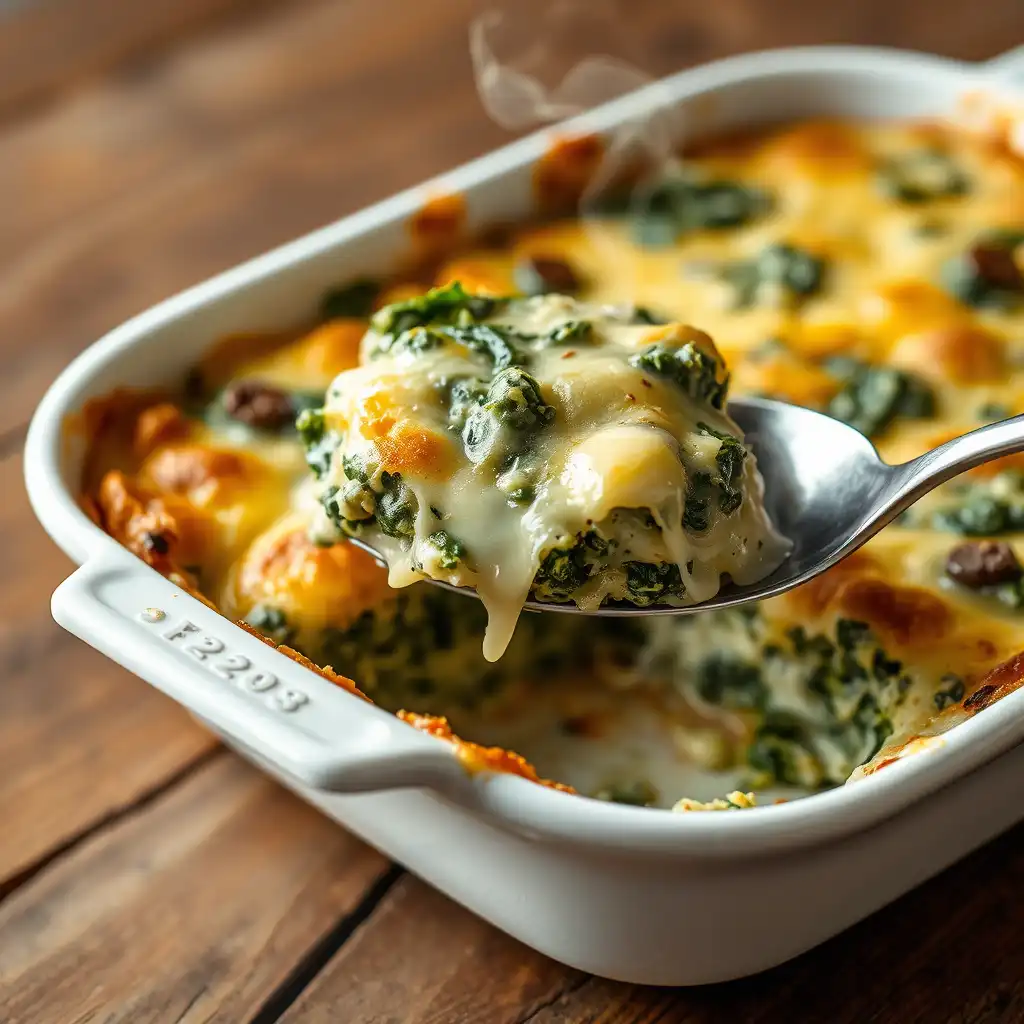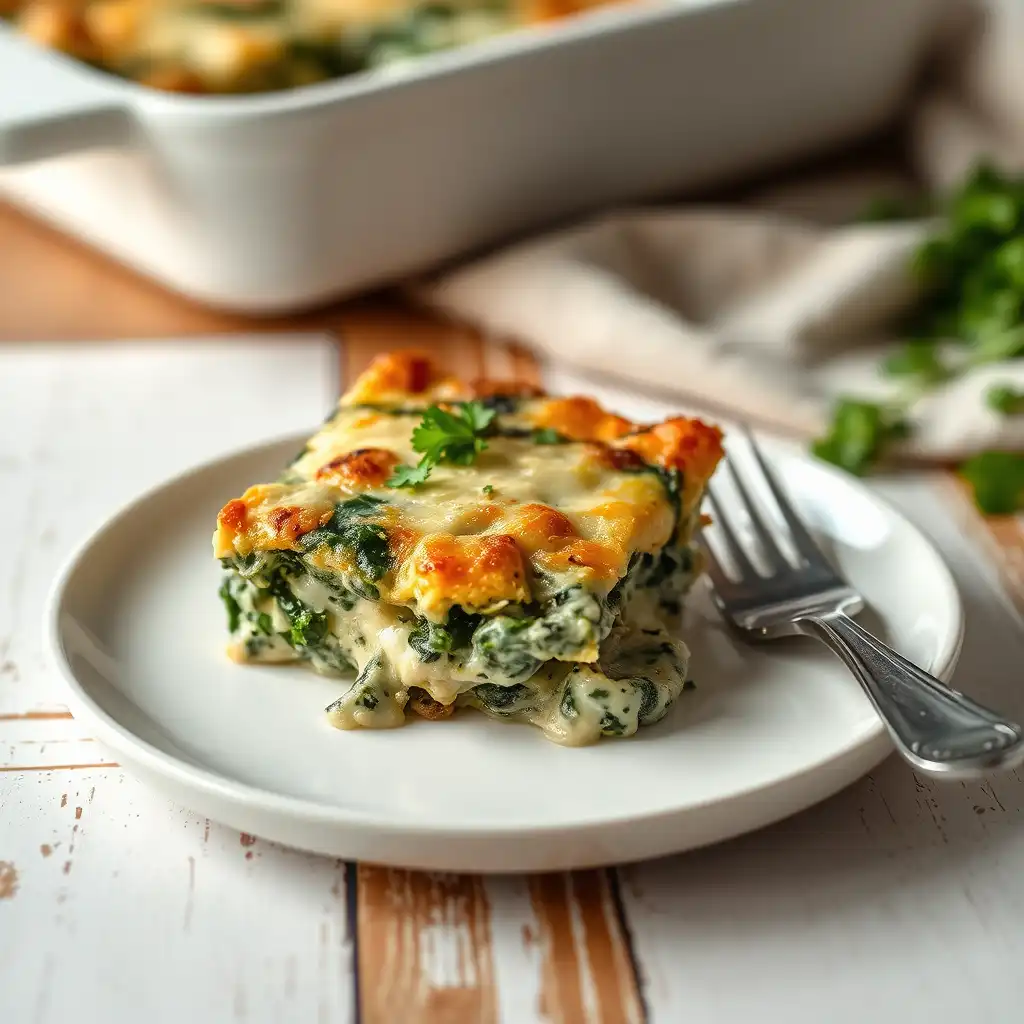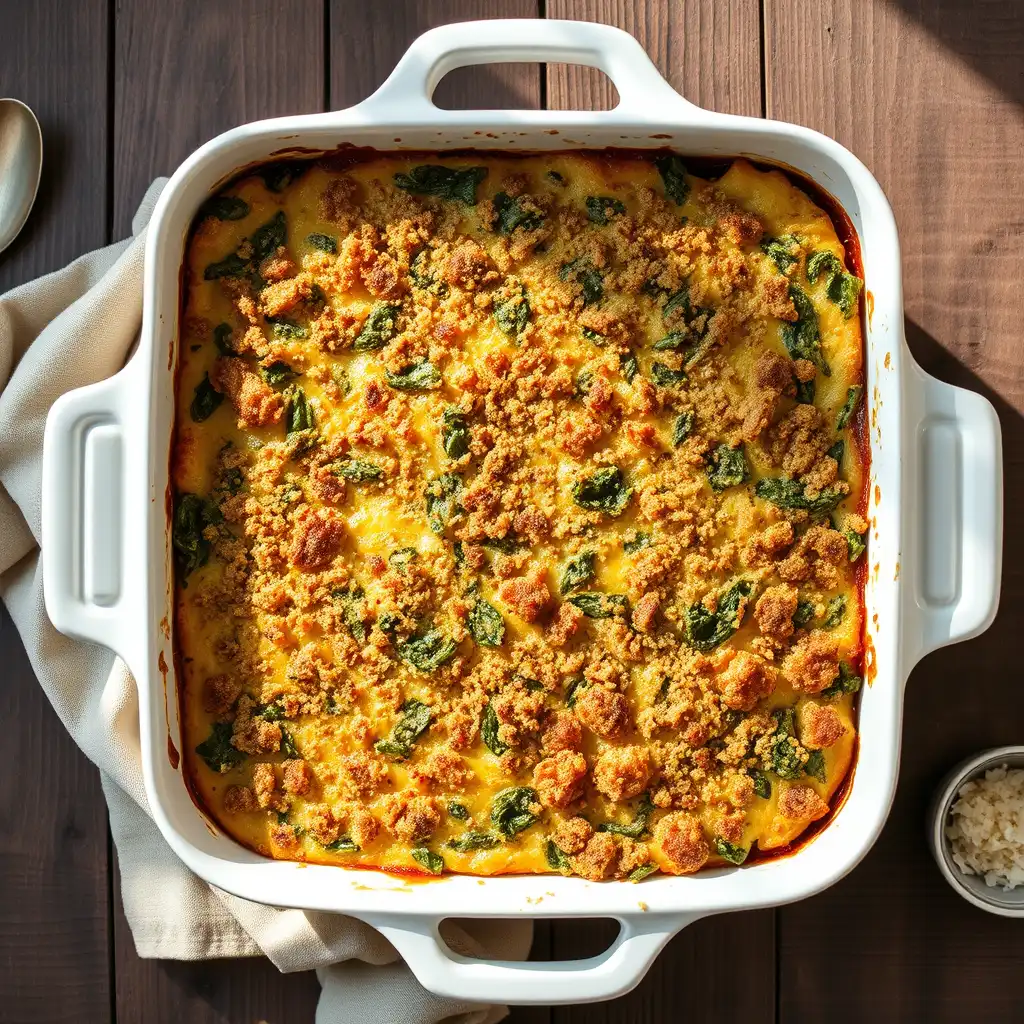Baked Spinach Casserole isn’t just dinner, it’s the warm hug you didn’t know you needed on a Tuesday night. I still remember the first time I made it for my aunt, who swore she hated spinach. Two bites in, she was already asking for the recipe, and I pretended it was some sort of ancient family secret (it wasn’t).
Baked Spinach Casserole has this quiet charm. It’s creamy without being heavy, earthy without tasting like a lawn, and indulgent enough to feel like comfort food yet still green enough that you don’t feel too guilty. The trick? Layering flavors in ways most people skip over because they’re in a rush.
Baked Spinach Casserole is special because it can shapeshift. It can be the star of a vegetarian dinner, a side dish for roasted chicken, or even a brunch main next to a poached egg. You can make it wholesome, or you can make it decadent—both versions will be devoured before the table’s cleared.
Ingredients & Substitutions
Baked Spinach Casserole works best with fresh spinach, about 1 pound, washed and dried well. Frozen spinach will do in a pinch, but make sure to squeeze out every drop of water unless you want a swampy mess in your dish.
Baked Spinach Casserole needs 2 tablespoons butter and 1 tablespoon olive oil—yes, both—because butter gives richness, and olive oil keeps the flavor from being too heavy. Skip one, and you’ll taste the difference.
Baked Spinach Casserole gets creaminess from 1 cup heavy cream, though half-and-half works if you want lighter. Whole milk… eh, it’s fine, but you’ll lose some silkiness. Dairy-free? Go for full-fat coconut milk or oat cream.
Baked Spinach Casserole uses 1 medium onion, diced fine, and 3 cloves garlic, minced. Don’t skimp here—these are the backbone of flavor. Shallots work beautifully if you want something milder.
Baked Spinach Casserole benefits from 1 cup shredded cheese. Gruyère melts like a dream, sharp cheddar adds bite, mozzarella gives that stretch. Mix them if you like chaos. Vegan cheese is acceptable if it actually melts (some don’t).
Baked Spinach Casserole needs seasoning—1 teaspoon salt, ½ teaspoon black pepper, ¼ teaspoon nutmeg. Nutmeg might sound odd, but it’s the whisper in the background that makes spinach sing.
Baked Spinach Casserole holds together with 2 large eggs. No eggs? Try a tablespoon of cornstarch mixed into the cream for structure.
Step-by-Step Instructions
Baked Spinach Casserole begins with preheating the oven to 375°F (190°C). Skipping the preheat is like showing up to a party without pants—unacceptable.
Baked Spinach Casserole starts on the stovetop. In a large skillet, melt butter with olive oil over medium heat. Add onion and cook until it’s soft and just starting to caramelize—about 5-6 minutes. Garlic goes in last so it doesn’t burn.
Baked Spinach Casserole needs the spinach wilted. Add it in handfuls, letting each batch collapse before adding more. If using frozen spinach, just stir it in until warmed through. Too much heat here and you’ll have bitter greens, so keep it gentle.
Baked Spinach Casserole’s cream mixture is simple. In a bowl, whisk together cream, eggs, cheese, nutmeg, salt, and pepper. Don’t overbeat or you’ll incorporate too much air, making it puff up weird in the oven.
Baked Spinach Casserole is assembled by combining the spinach mixture with the cream mixture. Stir until everything’s cozy. Taste it now—if it’s bland, add more salt. Baking won’t magically fix under-seasoned food.
Baked Spinach Casserole bakes in a buttered dish for 25-30 minutes, until the top is golden and the center is just set. Overbake, and you’ll lose that creamy center you worked for.
Baked Spinach Casserole should rest 5 minutes before serving. That pause lets the flavors settle and the structure firm up. Cut too soon, and it’ll collapse like a bad soufflé.

Cooking Techniques & Science
Baked Spinach Casserole relies on gentle sautéing to coax sweetness from onions without scorching garlic. High heat would give bitterness that fights the creaminess.
Baked Spinach Casserole benefits from combining butter and olive oil. Butter alone burns faster; oil alone lacks the depth. Together, they’re a stable fat with complex flavor.
Baked Spinach Casserole gets richness from cream, which coats spinach fibers, making the mouthfeel luxurious. Without fat, spinach’s oxalic acid can taste metallic—cream balances that.
Baked Spinach Casserole uses eggs as a custard base. As they cook, proteins set, giving the casserole shape. Without them, you’d have creamed spinach soup.
Baked Spinach Casserole is enhanced by nutmeg because it contains compounds that complement leafy greens’ earthy flavor. This pairing has been used for centuries in European cooking.
Baked Spinach Casserole baked in ceramic retains heat better than metal, ensuring an even set without browning too quickly. If you only have metal, reduce the baking time slightly.
Serving & Pairing Suggestions
Baked Spinach Casserole shines hot from the oven, but it’s surprisingly good at room temperature too, especially at brunch spreads.
Baked Spinach Casserole can be dressed up. Top with crisp breadcrumbs for texture, or drizzle with truffle oil for an upscale twist.
Baked Spinach Casserole pairs beautifully with roasted chicken, grilled salmon, or even a thick slice of sourdough bread. For wine, try a Chardonnay with some oak, or a Sauvignon Blanc if you like freshness.
Baked Spinach Casserole can join a holiday table next to turkey and stuffing, or it can be the green element in a weeknight dinner with rice and beans.
Baked Spinach Casserole is also freezer-friendly. Cool completely, wrap tightly, and reheat in the oven—never the microwave—if you want to keep the texture.

Conclusion
Baked Spinach Casserole is more than just “spinach in a dish.” It’s proof that vegetables, when treated with care and intention, can stand shoulder to shoulder with the most indulgent comfort foods.
Baked Spinach Casserole rewards the cook who takes time with onions, who seasons before baking, who understands that cream and greens aren’t enemies but perfect dance partners.
Baked Spinach Casserole, once mastered, becomes one of those dishes you can make without thinking. And when you do, people will ask for it again, even the ones who swear they don’t eat spinach.
Can I use frozen spinach for baked spinach casserole?
Yes, but thaw completely and squeeze out all water. Excess liquid will ruin the texture.
How do I make baked spinach casserole dairy-free?
Use full-fat coconut milk or oat cream for richness, and a good melting vegan cheese.
Can baked spinach casserole be made ahead?
Yes, assemble it, cover, refrigerate up to 24 hours, then bake when ready.
Why add nutmeg to baked spinach casserole?
It enhances spinach’s natural flavor, adding warmth without tasting sweet.
How do I prevent watery baked spinach casserole?
Dry spinach thoroughly, cook out moisture during sautéing, and avoid low-fat cream.

Olivia P. is a seasoned food blogger at Tastywink, sharing delicious, easy-to-follow recipes inspired by him passion for home cooking. With years of culinary blogging experience, he brings flavor, creativity, and a personal touch to every dish.
